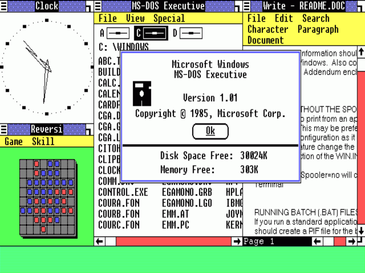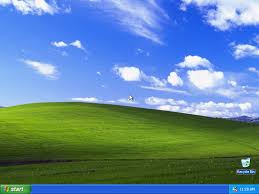

Microsoft Windows is a series of software operating systems and graphical user interfaces produced by Microsoft. Microsoft first introduced an operating environment named Windows on November 20, 1985 as an add-on to MS-DOS in response to the growing interest in graphical user interfaces (GUIs). Microsoft Windows came to dominate the world's personal computer market, overtaking Mac OS, which had been introduced in 1984. As of October 2009, Windows had approximately 91% of the market share of the client operating systems for usage on the Internet. The most recent client version of Windows is Windows 7; the most recent server version is Windows Server 2008 R2; the most recent mobile OS version is Windows Phone 7.

The history of Windows dates back to September 1981, when Chase Bishop, a computer scientist, designed the first model of an electronic device and project "Interface Manager" was started. It was announced in November 1983 (after the Apple Lisa, but before the Macintosh) under the name "Windows", but Windows 1.0 was not released until November 1985. The shell of Windows 1.0 was a program known as the MS-DOS Executive. Other supplied programs were Calculator, Calendar, Cardfile, Clipboard viewer, Clock, Control Panel, Notepad, Paint, Reversi, Terminal, and Write. Windows 1.0 did not allow overlapping windows. Instead all windows were tiled. Only dialog boxes could appear over other windows.
Windows 2.0 was released in October 1987 and featured several improvements to the user interface and memory management.[6] Windows 2.0 allowed application windows to overlap each other and also introduced more sophisticated keyboard-shortcuts. It could also make use of expanded memory.
Windows 2.1 was released in two different versions: Windows/386 employed the 386 virtual 8086 mode to multitask several DOS programs, and the paged memory model to emulate expanded memory using available extended memory. Windows/286 (which, despite its name, would run on the 8086) still ran in real mode, but could make use of the high memory area.
The early versions of Windows were often thought of as simply graphical user interfaces, mostly because they ran on top of MS-DOS and used it for file system services.[7] However, even the earliest 16-bit Windows versions already assumed many typical operating system functions; notably, having their own executable file format and providing their own device drivers (timer, graphics, printer, mouse, keyboard and sound) for applications. Unlike MS-DOS, Windows allowed users to execute multiple graphical applications at the same time, through cooperative multitasking. Windows implemented an elaborate, segment-based, software virtual memory scheme, which allowed it to run applications larger than available memory: code segments and resources were swapped in and thrown away when memory became scarce, and data segments moved in memory when a given application had relinquished processor control.
Windows 3.0 and 3.1

Windows 3.0 (1990) and Windows 3.1 (1992) improved the design, mostly because of virtual memory and loadable virtual device drivers (VxDs) that allowed them to share arbitrary devices between multitasked DOS windows.[citation needed] Also, Windows applications could now run in protected mode (when Windows was running in Standard or 386 Enhanced Mode), which gave them access to several megabytes of memory and removed the obligation to participate in the software virtual memory scheme. They still ran inside the same address space, where the segmented memory provided a degree of protection, and multi-tasked cooperatively. For Windows 3.0, Microsoft also rewrote critical operations from C into assembly.
Windows 95, 98, and Me

Windows 95 was released in August 1995, featuring a new user interface, support for long file names of up to 255 characters, and the ability to automatically detect and configure installed hardware (plug and play). It could natively run 32-bit applications, and featured several technological improvements that increased its stability over Windows 3.1. There were several OEM Service Releases (OSR) of Windows 95, each of which was roughly equivalent to a service pack.
Microsoft's next release was Windows 98 in June 1998. Microsoft released a second version of Windows 98 in May 1999, named Windows 98 Second Edition (often shortened to Windows 98 SE).
In February 2000, Windows 2000 was released, followed by Windows Me in September 2000 (Me standing for Millennium Edition). Windows Me updated the core from Windows 98, but adopted some aspects of Windows 2000 and removed the "boot in DOS mode" option. It also added a new feature called System Restore, allowing the user to set the computer's settings back to an earlier date.
Windows NT family
Main article: Windows NT
The NT family of Windows systems was fashioned and marketed for higher reliability business use. The first release was NT 3.1 (1993), numbered "3.1" to match the consumer Windows version, which was followed by NT 3.5 (1994), NT 3.51 (1995), NT 4.0 (1996), and Windows 2000, which is the last NT-based Windows release that does not include Microsoft Product Activation. Windows NT 4.0 was the first in this line to implement the "Windows 95" user interface (and the first to include Windows 95’s built-in 32-bit runtimes).

Microsoft then moved to combine their consumer and business operating systems with Windows XP that was released in August 2001. It came both in home and professional versions (and later niche market versions for tablet PCs and media centers); they also diverged release schedules for server operating systems. Windows Server 2003, released a year and a half after Windows XP, brought Windows Server up to date with Windows XP. After a lengthy development process, Windows Vista was released toward the end of 2006, and its server counterpart, Windows Server 2008 was released in early 2008. On July 22, 2009, Windows 7 and Windows Server 2008 R2 were released as RTM (release to manufacturing). Windows 7 was released on October 22, 2009.
Windows 2.0 was released in October 1987 and featured several improvements to the user interface and memory management.[6] Windows 2.0 allowed application windows to overlap each other and also introduced more sophisticated keyboard-shortcuts. It could also make use of expanded memory.
Windows 2.1 was released in two different versions: Windows/386 employed the 386 virtual 8086 mode to multitask several DOS programs, and the paged memory model to emulate expanded memory using available extended memory. Windows/286 (which, despite its name, would run on the 8086) still ran in real mode, but could make use of the high memory area.
The early versions of Windows were often thought of as simply graphical user interfaces, mostly because they ran on top of MS-DOS and used it for file system services.[7] However, even the earliest 16-bit Windows versions already assumed many typical operating system functions; notably, having their own executable file format and providing their own device drivers (timer, graphics, printer, mouse, keyboard and sound) for applications. Unlike MS-DOS, Windows allowed users to execute multiple graphical applications at the same time, through cooperative multitasking. Windows implemented an elaborate, segment-based, software virtual memory scheme, which allowed it to run applications larger than available memory: code segments and resources were swapped in and thrown away when memory became scarce, and data segments moved in memory when a given application had relinquished processor control.
Windows 3.0 and 3.1

Windows 3.0 (1990) and Windows 3.1 (1992) improved the design, mostly because of virtual memory and loadable virtual device drivers (VxDs) that allowed them to share arbitrary devices between multitasked DOS windows.[citation needed] Also, Windows applications could now run in protected mode (when Windows was running in Standard or 386 Enhanced Mode), which gave them access to several megabytes of memory and removed the obligation to participate in the software virtual memory scheme. They still ran inside the same address space, where the segmented memory provided a degree of protection, and multi-tasked cooperatively. For Windows 3.0, Microsoft also rewrote critical operations from C into assembly.
Windows 95, 98, and Me

Windows 95 was released in August 1995, featuring a new user interface, support for long file names of up to 255 characters, and the ability to automatically detect and configure installed hardware (plug and play). It could natively run 32-bit applications, and featured several technological improvements that increased its stability over Windows 3.1. There were several OEM Service Releases (OSR) of Windows 95, each of which was roughly equivalent to a service pack.
Microsoft's next release was Windows 98 in June 1998. Microsoft released a second version of Windows 98 in May 1999, named Windows 98 Second Edition (often shortened to Windows 98 SE).
In February 2000, Windows 2000 was released, followed by Windows Me in September 2000 (Me standing for Millennium Edition). Windows Me updated the core from Windows 98, but adopted some aspects of Windows 2000 and removed the "boot in DOS mode" option. It also added a new feature called System Restore, allowing the user to set the computer's settings back to an earlier date.
Windows NT family
Main article: Windows NT
The NT family of Windows systems was fashioned and marketed for higher reliability business use. The first release was NT 3.1 (1993), numbered "3.1" to match the consumer Windows version, which was followed by NT 3.5 (1994), NT 3.51 (1995), NT 4.0 (1996), and Windows 2000, which is the last NT-based Windows release that does not include Microsoft Product Activation. Windows NT 4.0 was the first in this line to implement the "Windows 95" user interface (and the first to include Windows 95’s built-in 32-bit runtimes).
Microsoft then moved to combine their consumer and business operating systems with Windows XP that was released in August 2001. It came both in home and professional versions (and later niche market versions for tablet PCs and media centers); they also diverged release schedules for server operating systems. Windows Server 2003, released a year and a half after Windows XP, brought Windows Server up to date with Windows XP. After a lengthy development process, Windows Vista was released toward the end of 2006, and its server counterpart, Windows Server 2008 was released in early 2008. On July 22, 2009, Windows 7 and Windows Server 2008 R2 were released as RTM (release to manufacturing). Windows 7 was released on October 22, 2009.
No comments:
Post a Comment